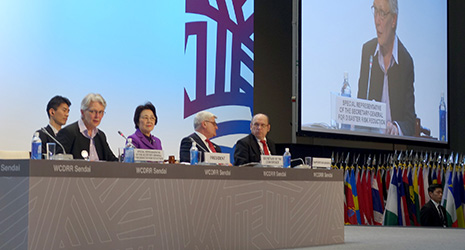Home > Highlighting JAPAN > Highlighting Japan December 2016 > Sixty Years of Commitment: Japan and the UNx
Highlighting JAPAN


Disaster Risk Reduction: Japan and the UNISDR
By working closely with the United Nations, Japan is contributing its profound knowledge of disaster risk reduction around the world.
Every year, many countries around the world suffer human and economic damage of disasters caused by natural hazards1, including earthquakes, typhoons, floods and droughts. According to the report “Poverty & Death: Disaster Mortality 1996–2015” issued by the United Nations Office for Disaster Risk Reduction (UNISDR) in October 2016, of the 1.35 million people killed by natural hazards over the past twenty years from 1996 to 2015, more than half died in earthquakes or tsunamis, with the remainder succumbing to weather-and climate-related disasters, such as typhoons. The majority of victims were those in low- and middle-income countries.
“Countries that need development aid are more vulnerable to natural hazards,” says Yuki Matsuoka, head of the UNISDR Office in Japan (located in Kobe, Hyogo Prefecture). “Accordingly, mainstreaming disaster risk reduction from a sustainable development perspective is very important. If we continue to undertake development without integrating disaster risk reduction perspective, we would create new risks and would not be able to reduce disaster risks no matter how hard we try.”
Established in 2000, UNISDR is headquartered in Geneva, Switzerland and coordinates international cooperation on disaster risk reduction including developing global frameworks, strategies and policies to reduce risk of disasters caused by natural hazards. Japan works in partnership with UNISDR to promote a global agenda on disaster risk reduction. One of these collaborations is demonstrated as the three UN World Conferences on Disaster Risk Reduction held in Japan. First held in Yokohama, Kanagawa Prefecture in 1994, the Conferences have since been held in 2005 in Kobe, Hyogo Prefecture, which suffered serious damage due to the Great Hanshin-Awaji Earthquake in 1995, and in 2015 in Sendai, Miyagi Prefecture, which suffered major tsunami damage as a result of the Great East Japan Earthquake in 2011. With more than 6,500 participants from 185 States, the Third UN World Conference on Disaster Risk Reduction adopted the Sendai Framework for Disaster Risk Reduction 2015–2030 and the Sendai Declaration, which included ideas suggested by Japan such as the importance of investment in disaster risk reduction, commitment by various stakeholders, and “Build Back Better.” In addition, Japan announced the Sendai Cooperation Initiative for Disaster Risk Reduction, which involved 4 billion dollars of financial cooperation and training of 40,000 government officials and local leaders over four years from 2015 to 2018.
“Due to its geographical characteristics, Japan has a long history of tackling various kinds of natural hazards, such as earthquakes, tsunamis, typhoons, floods and volcanic eruptions,” says Matsuoka. “Through these experiences, Japan has accumulated lessons, knowledge, and technology on disaster risk reduction. That is why Japan is able to contribute to the global learning on disaster risk reduction through sharing the abundant knowledge and expertise it has cultivated in the field of disaster risk reduction with the international community.”
In Japan, based on the experience of the Great Hanshin-Awaji Earthquake and the Great East Japan Earthquake, further emphasis has been placed on non-structural measures, such as education and awareness-raising activities, as well as structural measures such as infrastructure including embankments. For example, in the Great East Japan Earthquake, tsunami tendenko, a traditional idea according to which people should flee to the hills as quickly as possible without waiting for any instructions when a major earthquake occurs, as it may trigger a tsunami, passed down in the Tohoku district, saved many lives.
In December 2015, the UN General Assembly unanimously adopted the resolution that was jointly proposed by many UN Member States under Japan’s leadership. The resolution was to designate November 5 as World Tsunami Awareness Day, encourage the prompt dissemination of information through early warning systems, and make use of traditional knowledge, among other elements. The day of World Tsunami Awareness Day was selected based on an anecdote called “Inamura-no-hi,” which tells the story of a local leader who saved the lives of his fellow villagers by setting fire to his rice sheaves to lead people to a hill when a tsunami hit Wakayama Prefecture on 5 November 1854.
The UNISDR Office in Japan runs a variety of activities to disseminate these Japanese experiences at home and abroad. For example, on November 25 and 26 this year, the High School Student Summit on “World Tsunami Awareness Day” in Kuroshio was jointly organized by Kuroshio Town, Kochi Prefecture, and UNISDR Office in Japan. This is a major international gathering where more than 350 teenagers from thirty countries all over the world participated in field trips and discussions, and gave presentations on disaster risk reduction.
“Creating an inclusive society that does not exclude people who are considered socially vulnerable, such as the disabled, elderly, children and women, will result in a resilient society,” says Matsuoka. “The cooperation between the UNISDR and Japan will become even more important, and UNISDR Office in Japan wishes to be a bridge to further enhance the collaboration between Japan and UNISDR.”
© 2009 Cabinet Office, Government of Japan







